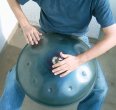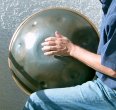Hang (musical instrument)
From Wikipedia, the free encyclopedia
A Hang [haŋ] (pronunciation between the vowel sounds in the word 'Hot' and 'Hungry') is a melodious and tuned steel idiophone created by PANArt in Switzerland. It uses some of the same physical principles as a steelpan but with a nitrided surface and structural change of having two clamped shells with a small opening so that the instrument is a Helmholtz Resonator. There has also been much metallurgical and acoustic research by the makers which have led to significant changes in structure, design, and process. It was the result of many years of research on the steelpan as well as the study of a diverse collection of instruments from around the world; such as gongs, gamelan, ghatam, drums, bells, etc. Ghatam/Udu-like sounds can be produced using the Helmholtz resonance that occurs within the clamped shallow shells. It also has the capacity to ring like a singing bowl. The instrument has sometimes been referred to by owners and others as a hang drum, because it is often played like a drum, its relation to the steel drum, and its popularity with hand drummers. While this is true, there are other ways to coax sound out of a Hang that do not involve 'drumming'.
Contents |
[edit] Playing the hang
The Hang is typically played resting on the player's lap, and can also be played on a stand. The Hang is generally played with the hands and fingers instead of mallets, so the sound is generally softer and 'warmer' than a traditional steelpan. Depending on how it is played the notes can sound like a harp, bells, or harmonically tuned steelpans.
[edit] Creation and Development
The Hang was developed in 2000 in Berne, Switzerland by Felix Rohner and Sabina Schärer (PANArt Hangbau AG) and introduced at the Frankfurt Music Fair in 2001. Its name comes from the Bernese German word for hand. The two deep drawn steel hemispheres of the Hang are hardened by a process known as gas-nitriding. The side considered the 'bottom' has an opening (Gu) in the center which is the bass note. When it is played in a dampened way it can change in pitch similar to a talking drum. On the 'top' are seven (in the bass version of the Hang) or eight (treble version which is no longer produced) notes arranged in a 'Tone Circle' in zig-zag fashion from low to high. All are tuned harmonically (with fundamental, octave and the fifth above the octave) around a low note (Ding) at the center of the Tone Circle.
There are only two people who make Hanghang (plural form of Hang), the inventors Felix Rohner and Sabina Schärer. They have a little workshop in Berne where every Hang in existence was created. From 2000 to 2005 the Hang was offered in multiple scales ranging from fifteen to up to forty five different 'Sound Models'. The center note (Ding) ranged from a E3 to A3 in the instruments often referred to as the First Generation Hanghang. The Hang Makers took their initial inspiration from ethnomusicological roots with models such as the Aeolian, Ake Bono, Hijaz, Melog, Pygmy, and Zhi Diao.
In the spring of 2006 the Hang Makers presented a new generation of Hanghang. The new instruments (often referred to as 2nd Generation) have a surface coating of annealed brass over the nitrided steel as well as a ring of brass around the circumference of the Hang. From the many different scales the Hang Makers reduced to a more stable and consistent structure consisting of a lowered central note (Ding) at D3. Most New Generation models have two A notes (A3 and A4) as well as another D (D4) in the Tone Circle around the Ding. The remaining notes were mixed into several different configurations. Older Hanghang had tone fields with the oval indentation oriented radially towards the Ding, with the 2007 models (as well as the Integral Hang) the tone fields are angled at about 45° from a line drawn from the Ding to the edge so both overtone 'sweet spots' are easy to reach from the Ding. They also started marking the individual serial number on the inside of the Gu opening and signing each Hang at the outside edge of the Gu side of the Hang.
In the spring of 2008 the Hang Makers presented a new Hang referred to as the Integral Hang. Numbers began again with an H in front (H1, H2, etc.) and it appears the first were created in November 2007. Several changes mark the Integral Hang. It now has only one scale (D3 Ding, A3, Bb3, C4, D4, E4, F4, A4). While the circumference remains a circle, the Gu side has been shaped very slightly as an oval from the spherical. Along with that shift, the Gu hole is now a subtly oval shape which creates two Gu ringing 'notes' - F and an F#. Significant changes have been made to the Ding (center note on the top). It now has a circular indentation in the dome and has a texture of brass applied, annealed, and then lacquered. The PANArt logo, serial number, date of finalization, and signatures of the Hang Makers are now on Gu side of the Hang near the equator where the two shells meet.
[edit] Sound Examples
 |
 |
[edit] Obtaining a hang
In 2006 the Hang Makers stopped shipping instruments directly and halted sales through retailers.[1] With that change PANArt indicated that to obtain a Hang, prospective customers were to mail a letter by post requesting an instrument. In 2007, purchasers were invited to Bern with an appointment time to select an instrument. With the distribution of the Integral Hang beginning in 2008, purchasers could choose between requesting an appointment in Bern, or having their Integral Hang shipped to them. In June 2008 there were reports, by those who had sent letters, of correspondence sent by PANArt indicating that the production of Integral Hang instruments had been spoken for, and that after the last Integral Hang was given to an owner (sometime in 2009) PANArt would take a "longer break" to decide how they would proceed in regards to the Hang. Requests received by mail and responded to would not be "thrown away" but the letter writers would be placed on a list.
In March of 2009 another letter was sent from PANArt as a response to written requests indicating that they "will of course continue making hanghang" but "will not be able to sell you a Hang this year" indicating that a break for a few months would be taken to develop and research the Hang further. They also indicated "we will inform you about our activities at the end of the year".
Worldwide offers for used Hanghang are rare, and prices in Internet auctions have been exceptionally high due to an increased demand since 2006 and a reduction in supply due to changes in the manufacture, a new sales agreement, and distribution of Hanghang.
[edit] Notes
- ^ PANArt Hang Booklet 2008 S. 14
[edit] References
- PANArt Hang Booklet 2008 by Felix Rohner and Sabina Schärer
- History, Development and Tuning of the HANG by Felix Rohner and Sabina Schärer
- Acoustics of the HANG: A hand-played steel instrument by Thomas D. Rossing, Andrew Morrison, Uwe Hansen, Felix Rohner and Sabina Schärer
- Sound of the Hang by David Wessel, Andrew Morrison, Thomas Rossing
- Extraordinary Sound of the Hang by Andrew Morrison and Thomas D. Rossing
[edit] External links
- Hang article in the Oddmusic Musical Instrument Gallery
- Hang-Music Forum (internet forum devoted to the Hang)
- The Hang Internet Index (Index of Websites dealing with the Hang)
- The Hang CD Index (Index of CDs with Hang music)
- The E-Hang (Virtual Hang that can be played online)





